Chapter 4
Learning Fire TV Basics
IN THIS CHAPTER
![]() Getting comfy with the Alexa Voice Remote
Getting comfy with the Alexa Voice Remote
![]() Making friends with the Fire TV mobile app
Making friends with the Fire TV mobile app
![]() Learning the lay of the Fire TV landscape
Learning the lay of the Fire TV landscape
![]() Taking voice control of Fire TV for a spin
Taking voice control of Fire TV for a spin
![]() Taking a tour of the Fire TV Home screen
Taking a tour of the Fire TV Home screen
At this point in your Fire TV career, you should have your Fire TV device attached to your TV (unless you have a Fire TV Edition Smart TV, where no such attachment is necessary), connected to your Wi-Fi network, and registered with your Amazon account. If you’ve checked all those items off your Fire TV to-do list, then I’m happy to report that you’re all set to start using Fire TV!
In this chapter, you take the next step by learning some crucial basics not only for Fire TV, but also for Amazon’s Fire TV mobile app. You learn how to use the Alexa Voice Remote, install the Fire TV mobile app, and get around the Fire TV interface. As a bonus, you also learn a few basic voice commands for controlling Fire TV using Amazon’s Alexa voice assistant. Crack your knuckles, clear your throat, and get ready to start playing with Fire TV!
Getting to Know the Alexa Voice Remote
One of the most important doodads that comes with your Fire TV device is the Alexa Voice Remote, which enables you to control Fire TV in two ways:
- Manually: Press the remote’s buttons to navigate the Fire TV interface and control playback.
- By voice: Use the remote’s built-in Alexa voice assistant to issue verbal instructions for navigating the interface and controlling content.
Touring the Fire TV Alexa Voice Remote
The Alexa Voice Remote will be your constant companion while you use Fire TV, so it pays to take a couple of minutes now to learn the lay of the remote land.
First, Figure 4-1 shows the version of the Alexa Voice Remote that ships with devices such as Fire TV Stick, Fire TV Stick 4K, and Fire TV Cube.
Here’s a summary of what you see on the face of the Alexa Voice Remote:
- Power: Press this button to turn your TV on and off.
- Microphone: The internal device that picks up your voice requests when you press and hold the Voice button.
- LED: Lights up when the Alexa Voice Remote is performing certain operations, such as signaling the remote’s readiness to be paired with a Fire TV device.
- Voice: Press and hold this button to make a voice request, as I describe a bit later in this chapter (see “Introducing Voice Control of Fire TV”).
- Navigation ring: Use this ring to navigate the Fire TV interface (see “Navigating with the Alexa Voice Remote,” later in this chapter).
- Select: Press this button to choose the item that’s currently highlighted on the Fire TV screen.
- Back: Press this button to go back to the previous Fire TV screen.
- Home: Press this button to jump directly to the Fire TV Home screen.
- Menu: Press this button to see a menu of commands that are specific to the item that’s currently highlighted on the Fire TV screen.

Photograph courtesy of Amazon
FIGURE 4-1: The Alexa Voice Remote that ships with Fire TV devices.
- Rewind: During playback, use this button to rewind the content as follows:
- Press the button once to rewind by ten seconds.
- Press and hold the button for a few seconds, and then release the button to continuously rewind at low speed.
- While rewinding at low speed, press the button again to continuously rewind at medium speed.
- While rewinding at medium speed, press the button again to continuously rewind at high speed.
- While rewinding at high speed, press the button again to switch to the low-speed rewind.
- To stop rewinding, press the Play/Pause button.
- Play/Pause: During playback, press this button to pause the content; press the button again to restart the content.
- Fast Forward: During playback, use this button to fast-forward the content as follows:
- Press the button once to fast-forward by ten seconds.
- Press and hold the button for a few seconds, and then release the button to continuously fast-forward at low speed.
- While fast-forwarding at low speed, press the button again to continuously fast-forward at medium speed.
- While fast-forwarding at medium speed, press the button again to continuously fast-forward at high speed.
- While fast-forwarding at high speed, press the button again to switch to the low-speed fast-forward.
- To stop fast-forwarding, press the Play/Pause button.
- Volume Up: During playback, press this button to raise the volume; press and hold this button to raise the volume quickly.
- Volume Down: During playback, press this button to decrease the volume; press and hold this button to decrease the volume quickly.
- Mute: During playback, press this button to toggle the volume off and on.
Touring the Fire TV Edition Alexa Voice Remote
If you’re doing the Fire TV thing using a Fire TV Edition Smart TV or Fire TV Edition Soundbar, then you get a slightly different configuration for the Alexa Voice Remote, as shown in Figure 4-2. This configuration has the same buttons as the Fire TV Alexa Voice Remote shown in Figure 4-1, but it also comes with the following extra buttons:
- Guide: Press this button to display the live TV channel guide (assuming you have live TV signals or apps; see Chapter 5).
- Hot buttons: These four buttons take you directly to the app for whatever streaming service is named on the button. For example, pressing the Netflix button opens the Netflix app. As a bonus, pressing one of the hot buttons also turns on your TV if it’s currently off.
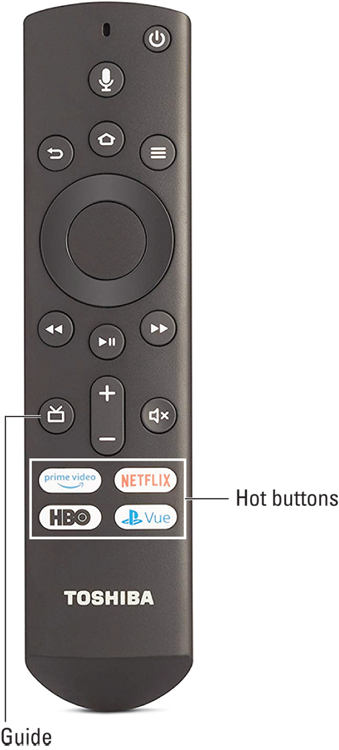
Photograph courtesy of Amazon
FIGURE 4-2: An example of an Alexa Voice Remote that ships with Fire TV Edition devices.
Checking Out the Fire TV Mobile App Remote
Although you’ll mostly use the Alexa Voice Remote to control your Fire TV, if you lose the remote or it’s not handy, you have an alternative: the Fire TV mobile app’s Remote feature.
Installing the Fire TV mobile app
The Fire TV mobile app is a program that you download to your smartphone or tablet. You mostly use it to control a Fire TV device, but if you have Fire TV Recast as part of your system, you can also use the app to watch over-the-air TV, record shows, and watch those recordings (see Chapter 7 to learn how all this works).
Okay, so what do you need to get the Fire TV mobile app? A smartphone or tablet that meets one of these qualifications:
- An iPhone or iPad running iOS 10 or later
- An Android phone or tablet running Android 5 or later
- An Amazon Fire tablet running Fire OS 3 or later
If you have one of these devices, go to your device’s app store, search for the Amazon Fire TV mobile app, and install it.
When you first open the Fire TV mobile app, you’re prompted to sign in with your Amazon account credentials. If you don’t see that prompt, you can also tap the Sign In button at the bottom of the screen.
Figure 4-3 shows the Sign-In page for the Fire TV mobile app on an iPhone.
Follow these steps to sign in:
-
In the Email field, type your Amazon account’s email address.
 If you use an Amazon mobile phone account instead of a standard Amazon account, type your mobile phone number into the field instead of your email address.
If you use an Amazon mobile phone account instead of a standard Amazon account, type your mobile phone number into the field instead of your email address.What if you don’t have an Amazon account? No problem. Tap the Create a New Amazon Account button; use the Create Account screen to type your name, email address, and a password; and then tap Create Your Amazon Account.
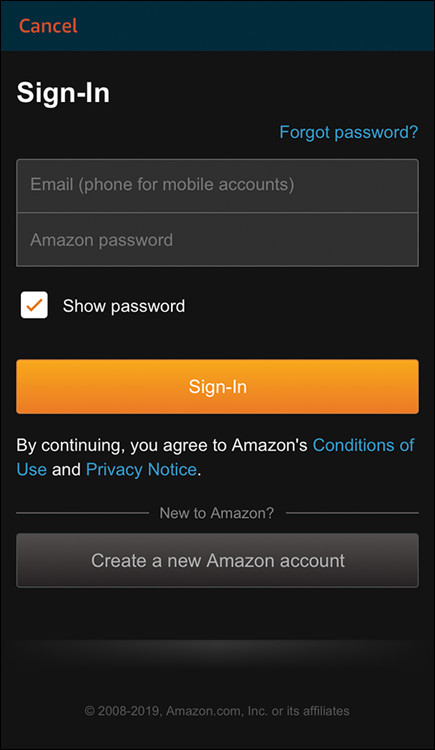
FIGURE 4-3: The iPhone version of the Fire TV mobile app’s Sign In page.
-
In the Amazon Password field, type your Amazon account’s password.
 By default, the Fire TV mobile app hides the password by displaying each character as a dot. If you want to make sure you entered the password correctly, select the Show Password check box.
By default, the Fire TV mobile app hides the password by displaying each character as a dot. If you want to make sure you entered the password correctly, select the Show Password check box. -
Tap the Sign In button.
The Fire TV mobile app confirms your Amazon credentials and then signs in to your account.
If you’ve enabled two-factor authentication on your Amazon account (see Chapter 12), the Fire TV mobile app will prompt you to enter a one-time password (OTP) to verify the sign-in. Type the code that was sent to you and then tap the Sign In button.
The Fire TV mobile app finishes loading, and you see the home screen, which will be similar to the one shown in Figure 4-4.

FIGURE 4-4: The Fire TV mobile app’s home screen.
Pairing your mobile device with Fire TV
The Fire TV mobile app will automatically detect your Fire TV device as long as both are on the same Wi-Fi network. In that case, the app’s home screen shows your Fire TV device or devices, as shown earlier in Figure 4-4.
To use the app with a Fire TV device, you have to connect them by following these steps:
- Run the Fire TV mobile app and display the home screen.
-
Tap the Fire TV device you want to control.
The first time you do this, your Fire TV device displays a four-digit code, as shown in Figure 4-5.
 Your code will almost certainly be different from the one shown here. So, don’t enter the code you see in this book; enter the code you see on your screen.
Your code will almost certainly be different from the one shown here. So, don’t enter the code you see in this book; enter the code you see on your screen. -
In the Fire TV mobile app, type the four-digit code in the spaces provided, as shown in Figure 4-6.
Fire TV connects your mobile device with your Fire TV device.

FIGURE 4-5: Your Fire TV device displays a four-digit code.
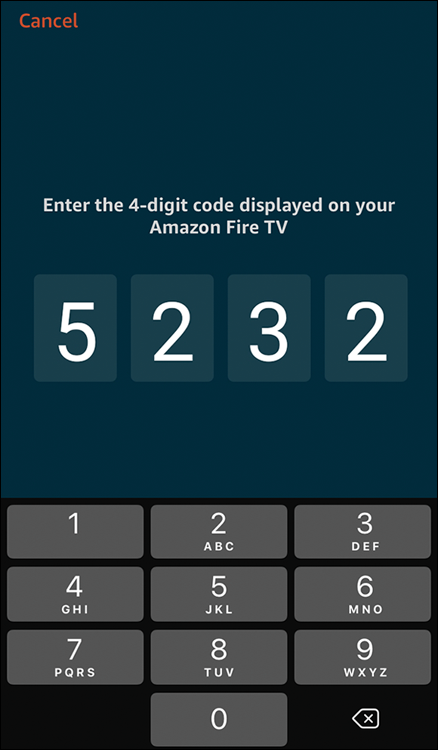
FIGURE 4-6: In the Fire TV mobile app, enter the four-digit code to connect the devices.
Touring the Fire TV mobile app remote
With your mobile device connected to your Fire TV device, you can control Fire TV using the Fire TV mobile app’s Remote feature. When you use the Fire TV mobile app to select a Fire TV device, you see a Remote screen similar to the one shown in Figure 4-7. I say “similar to” for two reasons:
- Figure 4-7 shows the Android smartphone version of the Remote screen. The tablet or iPhone version will have a slightly different look (although with the same layout).
- Figure 4-7 shows the Remote screen for a Fire TV Edition device. The Remote screen for a Fire TV device doesn’t include the Volume Up, Volume Down, and Mute buttons.
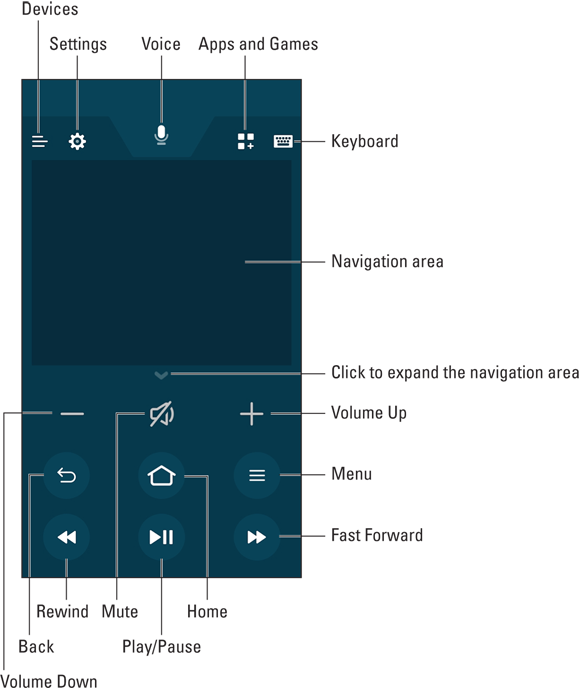
FIGURE 4-7: The Android version of the Fire TV mobile app’s Remote screen.
The buttons in the Fire TV mobile app’s Remote screen are mostly identical to those on the Alexa Voice Remote, which I describe earlier in this chapter (see “Getting to Know the Alexa Voice Remote”). However, at the top of the Fire TV mobile app’s Remote screen, there are four unique buttons:
- Devices: Tap this button to return to the list of your Fire TV devices.
- Settings: Tap this button and then tap Settings to display your Fire TV device’s Settings screen. You can also tap this button and then tap Sleep to put your Fire TV device into sleep mode.
- Apps and Games: Tap this button to display the Apps and Games screen, which displays an icon for each app and game installed on your Fire TV device.
- Keyboard: Tap this button to display an onscreen keyboard for entering text on the Fire TV screen (for the details, see “Entering text with the Fire TV mobile app keyboard,” later in this chapter).
I should also mention that the navigation area in the Fire TV mobile app doesn’t work the same as the navigation ring on the Alexa Voice Remote. To learn what’s different about the app’s navigation area, see “Navigating with the Fire TV mobile app,” later in this chapter.
Navigating the Fire TV Interface
Getting around the Fire TV interface can be a tad confusing at first. To help reduce the initial learning curve, remember that navigating the screen essentially means scrolling through two types of onscreen elements:
- Commands: These are usually text, but they can also be icons (such as the magnifying glass that indicates the Fire TV Search feature). The commands you’ll deal with most often are the items that run across the top of the Fire TV Home screen: Home, Live, Your Videos, and so on.
- Tiles: These are rectangles that represent apps, TV features (such as inputs), and items in the channel guide.
In the next two sections, I describe how you navigate the Fire TV interface using the Alexa Voice Remote and the Fire TV mobile app. Before I get to that, however, you may be asking yourself, “How will I know ‘where’ I am on the screen as I navigate?”
Great question! As you move about the interface, Fire TV moves a selector that highlights the current item. The look of the selector depends on the type of screen element:
- If the highlighted element is a command, Fire TV displays that command in orange text rather than the standard white text, as shown in Figure 4-8.
- If the highlighted element is a tile, Fire TV expands the tile slightly and adds a border around the tile, as shown in Figure 4-9.

FIGURE 4-8: Fire TV displays a highlighted command in orange text.

FIGURE 4-9: Fire TV displays a highlighted tile expanded with a border.
Navigating with the Alexa Voice Remote
With the Alexa Voice Remote, you mostly navigate the Fire TV interface using the navigation ring, shown in Figure 4-10.
As pointed out in Figure 4-10, there are four “buttons” on the ring:
- Up: This is the top part of the ring; you press this button to move the selector up in the current Fire TV screen.
- Down: This is the bottom part of the ring; you press this button to move the selector down in the current Fire TV screen.
- Left: This is the left part of the ring; you press this button to move the selector to the left in the current Fire TV screen.
- Right: This is the right part of the ring; you press this button to move the selector to the right in the current Fire TV screen.

Photograph courtesy of Amazon
FIGURE 4-10: The Fire TV interface navigation buttons on the Alexa Voice Remote.
When the selector is on the item you want to work with, press the Select button (refer to Figure 4-10) to choose that item.
To return to the previous Fire TV screen, press the Back button; to return directly to the Home screen, press the Home button (refer to Figure 4-10).
Entering text with the Alexa Voice Remote
Most of your Fire TV navigation efforts will involve using the Alexa Voice Remote Up, Down, Left, and Right buttons to move the selector to the item you want to choose. More often than you may think, however, Fire TV asks you to enter text. It may be sign-up or sign-in data for a streaming service, a network password, or a search request.
With Fire TV, you can enter text the easy way or the hard way. The easy way depends on what type of text Fire TV is asking for:
- For a search request, it’s easiest to use your voice to tell Alexa what you’re looking for (see “Introducing Voice Control of Fire TV,” later in this chapter).
- For all other text inputs, it’s easiest to use the keyboard that comes with the Fire TV mobile app (see “Entering text with the Fire TV mobile app keyboard,” later in this chapter).
What if you’re in a situation where you can’t use your voice (because, say, you don’t want to disturb people nearby) and you don’t have the Fire TV mobile app handy? In those cases, you need to enter your text the hard way, which means using the Alexa Voice Remote navigation ring.
The idea is that when Fire TV requires some text, it displays an onscreen keypad. The layout of that keypad depends on the type of text that Fire TV requires. For example, Figure 4-11 shows the onscreen keypad for a password, while Figure 4-12 shows the keypad for a search.

FIGURE 4-11: The Fire TV onscreen keypad for entering a password.
Here’s the basic procedure:
-
Use the navigation ring’s Up, Down, Left, and Right buttons to highlight the character you want to enter.
As you move through the keypad, Fire TV moves the selector to show you the highlighted character.
-
Press the Select button to choose the character.
Fire TV adds the character to the text box.
- Repeat Step 1 and 2 until you’ve entered all your text.
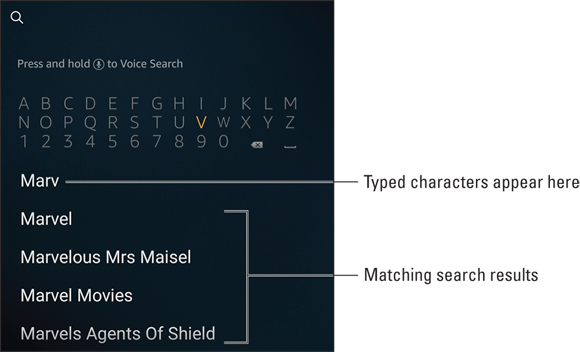
FIGURE 4-12: The Fire TV onscreen keypad for searching.
Yep, it’s painful for all but the shortest text entries. Fortunately, Fire TV offers a few shortcuts that you can take advantage of:
- Press Fast Forward to enter a space.
- Press Rewind to delete the most recent character.
- In keypads that support both lowercase and uppercase letters, press Menu to toggle the keyboard’s letters between lowercase and uppercase.
- In keypads where you have to confirm your text entry (such as the Connect button in Figure 4-11), press Play/Pause to choose the confirmation button.
- In keypads that offer a Cancel button (again, refer to Figure 4-11), press Back to choose that button.
Navigating with the Fire TV mobile app
With the Fire TV mobile app, you mostly navigate the Fire TV interface using the navigation area. There are three techniques to master:
- To move the selector one item at a time, briefly swipe inside the navigation area in the direction you want the selector to move. For example, to move the selector down one item, briefly swipe down in the navigation area.
- To move the selector quickly across multiple items, tap and hold anywhere inside the navigation area to display the navigation ring; then drag your finger in the direction you want to move the selector. For example, to move the selector to the left, drag your finger to the left; the left portion of the navigation ring lights up, as shown in Figure 4-13.
- To choose the highlighted item, tap anywhere within the navigation area.

FIGURE 4-13: Tap and drag within the navigation area to move the selector (such as to the left, as shown here).
To return to the previous Fire TV screen, press the Back button; to return directly to the Home screen, press the Home button (refer to Figure 4-1).
Entering text with the Fire TV mobile app keyboard
Earlier I mention that using the Alexa Voice Remote navigation ring to type one character at a time is a slow and cumbersome way to enter text. Entering text via voice, as I describe in the next section, is certainly easy, but not always practical (say, if people are nearby) or possible (say, if you’re entering a password).
Fortunately, Fire TV gives you a third method for entering text: the Fire TV mobile app’s onscreen keyboard. This is a standard mobile device keyboard that you can use to quickly type whatever text you want to enter into the Fire TV interface. Here’s how it works:
- In the Fire TV mobile app, connect to the Fire TV device you want to control.
-
Navigate to the Fire TV item that requires text input, such as the Search feature or the sign-in screen for a streaming app.
As soon as you navigate to a field that requires text, the Fire TV mobile app automatically displays the onscreen keyboard.
 If the onscreen keyboard doesn’t appear, tap the Keyboard icon (refer to Figure 4-7).
If the onscreen keyboard doesn’t appear, tap the Keyboard icon (refer to Figure 4-7). -
Use the keyboard to type your text entry.
The letters you type appear near the top of the app screen, as shown in Figure 4-14, as well as in the Fire TV text field on your TV.

FIGURE 4-14: Use the Fire TV mobile app’s onscreen keyboard to enter text into a Fire TV text field.
Introducing Voice Control of Fire TV
I discuss voice control of Fire TV in depth in Chapter 9. For now, let me give you a quick introduction to using Alexa to control your Fire TV.
The first thing you need to know is that there are actually two types of voice control for Fire TV:
- Near-field: The microphone that picks up your voice must be close to you (say, no more than arm’s length). This is the type of voice control at work when you use the Alexa Voice Remote that comes with your Fire TV device.
- Far-field: The microphone that picks up your voice can be relatively far away — up to about 20 feet. This is the type of voice control at work when you incorporate an Alexa-enabled device, such as a Fire TV Cube or an Echo smart speaker, into your Fire TV system (see Chapter 9).
Issuing voice commands using the Alexa Voice Remote
For utterances (as Amazon likes to call the verbal directives you send Alexa’s way) that fall under the near-field rubric, follow these steps:
-
Press and hold the Voice button on the Alexa Voice Remote.
Fire TV displays a blue bar across the top of the screen to indicate that Alexa is listening, as shown in Figure 4-15.
- State what you want Alexa to do.
-
Release the Voice button.
Alexa carries out your request (or, at least, tries to).

FIGURE 4-15: When you press and hold the Voice button, a blue bar appears at the top of the screen.
Issuing voice commands using the Fire TV mobile app
To issue a voice command using the Fire TV mobile app, follow these steps:
- In the Fire TV mobile app, connect to the Fire TV device you want to control.
-
Drag down the Voice button (refer to Figure 4-7) until you see the text “Listening …” on the screen (see Figure 4-16) and then hold your finger there.
The first time you drag down the Voice button, Fire TV asks your mobile device for permission to continue:
- On iOS, Fire TV asks for permission to use the microphone. Tap OK to grant that permission.
- On Android, Fire TV asks permission to record audio. Tap Allow to grant that permission.
- Let Alexa know what you want it to do.
-
Release the Voice button.
Alexa carries out your command.
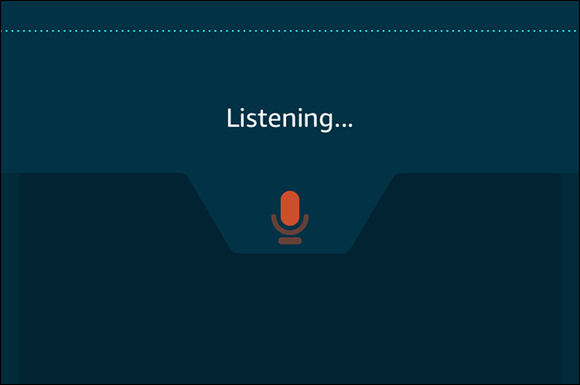
FIGURE 4-16: Drag down the Voice button to get Alexa listening for your command.
Learning some useful voice commands
I run through a long list of possible utterances in Chapter 9, but here are a few of the most useful ones to get you started:
- “Find [title]” (for example, “Find Star Trek”).
- “Find [title] [type]” (for example, “Find Star Trek TV show”).
- “Find [genre]” (for example, “Find comedies”).
- “Play [title]” (for example, “Play Fleabag”).
- “Play [title] [type]” (for example, “Play M*A*S*H movie”).
- “Fast forward.”
- “Rewind.”
- “Pause.”
- “Play” (or “Resume”).
- “Turn volume up/down.”
- “Mute.”
Looking Around the Fire TV Home Screen
When you start up your Fire TV Edition Smart TV, or when you switch to your Fire TV input, you come face-to-face with the Fire TV Home screen, which looks something like the one shown in Figure 4-17.

FIGURE 4-17: An example of a Fire TV Home screen.
Across the top of the screen are a series of tabs that take you to different areas of the Fire TV interface. Here’s a quick summary of what each tab represents:
- Search (magnifying glass icon): Enables you to search the Fire TV interface for apps, movies, TV shows, and other content.
- Home: Displays the Fire TV Home screen.
- Live: Displays all your live TV sources, including apps that offer live TV (such as Hulu + Live TV and Pluto TV), Fire TV Edition antenna or cable channels, and Fire TV Recast over-the-air channels.
- Your Videos: Displays movies and TV shows that you’re watching (or have watched) and your Prime Video Watchlist of shows you’d like to see.
- DVR: Shows current and recorded over-the-air TV shows. Note that you only see this tab if you have a Fire TV Recast device connected to your network (see Chapter 7).
- Movies: Displays the movies available through your subscription services.
- TV Shows: Displays the TV shows available through your subscription services.
- Apps: Displays featured apps for streaming services and other content.
- Settings: Displays the settings for customizing and configuring Fire TV.
Below the tabs, you see the Featured section, which displays content that Amazon wants to highlight. Fire TV describes the Featured section as a rotator because when you navigate into the Featured section, it begins automatically rotating through the content. You can also navigate the featured content manually by pressing the navigation ring’s Right and Left buttons. To get out of the previews, press the Back button.
Below the Featured section, Fire TV displays a series of rows, each of which is populated with a bunch of tiles, mostly for streaming apps. The first row is always Recent, which displays your eight most recently viewed apps.
To remove an item from the Recent row, highlight it, press the Menu button, and then choose Remove from Recent.
Other rows include Your Apps & Games, Inputs (Fire TV Edition Smart TVs only), Top Movies, Top TV, and Top Free Games.
